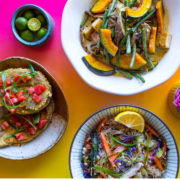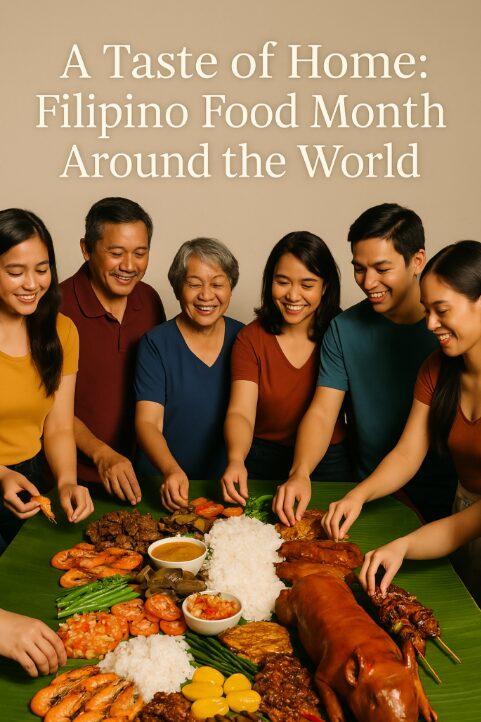
Chef, food educator and advocate Aileen Suzara aims to promote sustainable and healthy Pinoy food practices
WITH Filipino food’s presence increasing in the mainstream, it is also hard to ignore that Filipinos and Filipino-Americans have high rates of chronic diseases such as type 2 diabetes, high blood pressure and heart disease. Because of this, some people tend to take a step back on Filipino cuisine, as they perceive it to be one of the main causes of these diseases.

Chef, food educator and advocate Aileen Suzara begs to disagree, explaining that these perceptions are “relatively recent.”
“Digging into the roots of Filipino food culture reveals how closely our foods were — and are — tied to the land, sea, and seasons. Traditional methods focused on boiling, steaming, grilling, and naturally fermenting or preserving foods — or serving them fresh as can be, like kinilaw. Meats we consider trademarks today (like pork) could not be staples for most people, given how costly and labor intensive hunting or raising animals used to be,” she explained.
“Meats were precious — used more like a flavoring for ulam, in smaller portions than we see today, and for special occasions. Fish and seafood would be more abundant, especially in coastal regions.”
Suzara even points out that our idea of rice — which is a staple in Filipinos’ diets — has changed.
“I grew up thinking [that] eating a Filipino diet meant eating only white rice and that brown rice was ‘White people health food,’ and had my mind blown realizing there are thousands of varieties of rice, in a rainbow of colors,” she said.
Recognizing history and finding connections to health
A lot of people have reasoned and acknowledged that Filipino dishes, such as lechon (roasted pig) are greasy and unhealthy. Suzara, however, explained that there are better — and healthier ways to make Filipino food. A start is to look into our history to find the connections to the way we eat and how it has changed.
“It’s essential to recognize history, especially as our community faces an epidemic of diet-related chronic diseases like type II diabetes, heart disease and hypertension. I know how frustrating it can be to look for resources on ‘healthy eating’ and not see yourself reflected — the nutrition field is still largely Eurocentric, and has a long way to go in better representing the wisdom of many food traditions found in the U.S. These stereotypes do a disservice when they pose a false choice of culture vs health,” she stressed.
During her research into food during World War II and the American colonial period, Suzara learned that the colonial system not only enforced the English language to Filipinos, but also home economics classes tapered to the “American nutrition” at the time. This introduced processed and imported food from brands like Hershey’s and Hormel.
“A more common diet — such as munggo (mung beans), fish, vegetables, and colorful rice — would have been considered nutritionally inferior, and we now know is the opposite,” she explained.
Suzara believes that we can be healthy without leaving our food culture behind by getting inspiration from a wealth of foods that are both traditional and contemporary.
“There are certainly foods that are fatty, sweet and salty — party foods and treats exist in any culture,” she said. “We don’t need to throw these away, either. Instead, we can make more room in our plates and palates for foods that keep us healthy and strong.”
Growing up in Hawai’i, Suzara also noted that she was surrounded by markets that are full of produce, such as long beans, bittermelon, eggplants, banana hearts and more, all planted by longtime Filipino farmers.
“In CA (California), earlier generations shaped the farmworker and labor movement, and there are still farmers both new and old who carry on these traditions. Elders have [been] practicing ‘urban gardening’ before it became trendy again,” Suzara said.
Raising the flavor profile of vegan/vegetarian dishes
“Our people were among the world’s most skillful vegetable farmers, and our traditional foods reflect this agrarian heritage. I think of this when I hear comments that ‘Filipinos don’t eat vegetables’” she said.
For those who are thinking of going meatless (or at least plan to eat more vegetables) but are scared of how it will taste like, Suzara has a few ideas.
“If people are unfamiliar with ingredients, or have had them poorly prepared, it can seem like these foods must be bland or boring. Luckily, vegetables can be just as — and sometimes even more than — flavorful and creatively prepared as meat. I’d recommend people try an approach of ‘more’ vs ‘elimination,’ she said and continued, “For example, ‘how can I focus on bringing in more colors, textures, and varieties of vegetables into my daily meals, vs focusing on what to take away?’”
She suggests dark leafy greens, like kamote greens, kangkong and bok choy, because of the taste, nutritional value and can cook quickly. Adding seasonings like calamansi or lemon, chilis and garlic help add to its flavor profile.
“Making small steps is [the] important thing to getting started! Having a buddy system — a friend or family members — can be motivating and make the process fun,” Suzara said.
“For parents who worry they may have the added labor of cooking different foods for themselves and their kids, I’d encourage them to involve kids with cooking ‘new’ foods as much as possible and incorporating it into their diet as well. Easier said than done, for sure, but as I’ve found while cooking and teaching children and youth, kids are more likely to try new foods when they have an active role in preparing it, and also try it multiple times. Some families might opt to make it a weekly tradition and do ‘Meatless Mondays,’ then go from there.”
At present, Suzara is also busy with her food business, Sariwa (Tagalog for “fresh”), which she started when she reconnected with her Filipino roots.
“I was inspired by flavors tasted while visiting rural areas of the Philippines, in Hawai’i, and while reconstructing dishes found in old cookbooks. When I spent two years as an organic farmer in coastal California, I was immersed in agriculture and was able to grow, taste and cook with some of the freshest and most delicious ingredients, and I wanted to find out how to make them more accessible,” she shared.
Sariwa had its first big pop-up in Oakland in 2011, with the support of the Peoples Kitchen Collective and as a benefit for Filipino/American Coalition for Environmental Solidarity’s (FACES) typhoon relief efforts.
“It took more years of experimentation and work in the public health world before I decided to return to the kitchen. I was concern about the growing chronic disease epidemic our community faced, and also disturbed by the times I’d heard friends or community members share that they were instructed to ‘stop eating Filipino food before it kills you,’” she said. “I realized the most direct way of touching people’s palates was through our tastebuds, and to show how eating for health could also taste good and celebrate culture. I wanted to find ways to make health more celebratory, and to find a practical way to support local farmers who are growing heritage crops.”
Sariwa has grown as a food business since 2016, with the support of La Cocina, a nonprofit that supports low-income women, people of color and immigrants. Aside from this, Sariwa brings workshops and food demos to schools, clinics and public events, as well as collaborates with community organizations.
“Health and wellness are already within our roots. We have a wealth of practices that we can now bring forward to fit our 21st-century lives, and have the tools to feed ourselves in ways that honor our ancestors, heals our bodies, and takes care of the earth,” she said.
A podcast featuring Sariwa and healing within Filipino-American foods will soon be posted on https://www.realfoodrealtories.org/.






